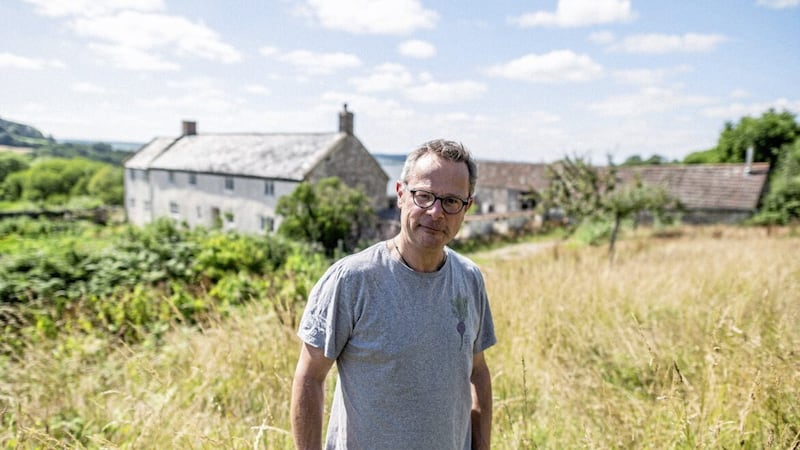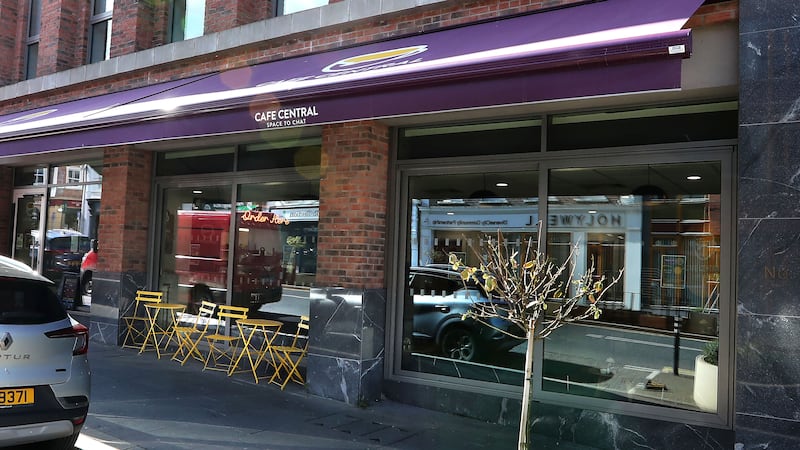HUGH Fearnley-Whittingstall wants everyone to know we've been swindled. And the culprit? Sugar.
"We've been conned into eating more sugar than we even have a genuine appetite for," he says, good-natured outrage bubbling from his words.
"Of course, a lot of us have a sweet tooth - I would say I have a really sweet tooth.
"But what I found is even my sweet tooth is completely satisfied by much less sugar than conventional recipes, and certainly industrially produced biscuits, cakes, sweets and puddings tend to include. We definitely need a sugar rethink."
Fearnley-Whittingstall's River Cottage has been re-evaluating its relationship with sugar for a few years now.
"We started taking some of the sugar out of our bakes and treats and desserts several years ago, and nobody even noticed. If anything, we were getting more feedback saying, 'God, that's so delicious'," he says.
Recipes in his new book, River Cottage Good Comfort, might have a less tooth-rotting amount of sugar in them, but you won't necessarily miss anything.
"Dialling down the sugar and the refined ingredients is part of it, but dialling up the whole ingredients is what the book's more about," Fearnley-Whittingstall adds.
And don't worry - the desserts are still sweet. After all, this is the person who admits to whipping up boxes of chocolates as a child.
"I used to make coffee and peppermint creams and dip them in chocolate - and truffles, things like that," Fearnley-Whittingstall remembers.
But the sweetness is adjusted, and other ingredients are added - such as parsnips or carrots into cakes, or a date syrup instead of a "knee-trembling amount of fudgy toffee".
This is all part of the 57-year-old chef and food writer's mission to get us eating a bit more healthily - and that doesn't mean you have to miss out on your favourite, stodgy comfort foods.
"We shouldn't be guilt-tripping people into eating healthy food, we should be tempting people to healthy food," he says.
After a "strange few years", it made sense for Fearnley-Whittingstall to dedicate his latest book to comforting, nostalgic recipes.
"During lockdown, a lot of people began reaching back to those favourite family recipes, those reliable cockle-warmers - the things that make us feel good, and make us feel that family is close by," he reflects.
"Enjoying something which not only do we love to eat, but has some kind of resonance and a little bit of emotional goodness to it."
For him, the challenge was being able to 'healthify' classic comfort dishes - like spag bol, shepherd's pie or crumble - without compromising on the taste. Some dishes took a bit more testing than others.
"People think, 'Today I'll be virtuous, and tomorrow maybe I'll kick up my heels and put my feet up and indulge'," he says.
"Actually, we can have both on the same plate and both in the same dish. We can enjoy treats, foods that are really well balanced - they've got lots of good things in them. Often that means a few little tweaks, and sometimes there are some bigger tweaks, but it's all very doable."
Ultimately, Fearnley-Whittingstall wanted to keep all the key tenets of comfort food intact.
"We can still capture the cockle-warming, saucy, gooey, whatever the particular characteristic is - crispy-topped, or a gooey brownie, or a crumble with custard and lovely fruit underneath," he enthuses.
"We can have all those things and they can be truly delicious - and yet better for us than perhaps some of the old-school or conventional versions of those recipes."
But why are we so drawn to comfort food? "I've got a slightly highfalutin answer to that, I hope you'll bear with me," says Fearnley-Whittingstall.
"I think the idea of comfort food is incredibly deeply ingrained in our entire food history, and it goes way back to when we were hunter-gatherers, where basically the entire human race - wherever you were on the planet, such as it was then - woke up to the same problem, which is what are we going to eat today?
"For millennia, that was the human race's relationship with food, and it was pretty much all you thought about all day.
"Often, it was very hard work, and sometimes it was scary, because food was scarce. I think comfort food comes from that moment when, once in a while, there was enough, there was plenty to go around.
"For the duration of that meal, everybody could relax, everybody could tell a story and everyone could smile."
For this cook, the same applies today. "Fast-forward a few thousand years, and going back down the generations of the comfort foods we eat, those ones represent those moments of family togetherness, plenty, we're not too short of everything, we've got what we need, and we're content," he explains.
"Even as I say that, I'm aware that is a notion that's under challenge at the moment from the really tough times we're having.
"But for me, that means finding these moments of comfort around the table becomes more important.
"It becomes tougher sometimes to find the ingredients and turn on the oven - all those things are becoming harder and more expensive. But we still need to do that, because it's what keeps us sane and warm and together."
:: River Cottage Good Comfort by Hugh Fearnley-Whittingstall is published by Bloomsbury, priced £27. Photography by Simon Wheeler. Available now.
****
CHICKEN AND CHORIZO RICE
“There are various incarnations of one-pan chicken and rice dishes, originating from all over the world, and this version, which includes some lovely Spanish flavours, is one of my favourites,” says Hugh Fearnley-Whittingstall.
“It’s delicious and satisfying, with tangy sweet peppers and tomatoes, and spicy chorizo, to balance the soothing rice, chicken and brothy juices.”
Ingredients:
(Serves 6)
1 large or 2 medium onions, sliced
3 red, orange or yellow peppers, deseeded and sliced
2 fat garlic cloves, sliced
100g chorizo, diced
1-2tbsp olive or rapeseed oil
1 bay leaf
250g brown rice (such as basmati), well rinsed
1 small chicken, jointed, or 6 bone-in chicken thighs
200ml white wine
About 500ml well-flavoured chicken stock
200g cherry tomatoes, halved if large
Sea salt and black pepper
Method:
1. Preheat the oven to 190C/170C Fan/Gas 5.
2. Put the onion(s), peppers, garlic and chorizo into a large roasting dish with just a trickle of oil (the chorizo will release its own fat so you don’t need much). Add the bay leaf and some salt and pepper and toss together well. Place in the oven for 25 minutes.
3. Tip the rice into a saucepan, cover with plenty of boiling water and bring to a simmer. Cook for 20 minutes, until almost al dente (still firm to the bite), then drain.
4. Heat a trickle more oil in a large frying pan over a medium-high heat. Season the chicken skin. Put half the chicken pieces into the pan, skin side down, and season their other sides. Fry the chicken for around eight minutes, turning occasionally, until each piece is nicely browned. Transfer to a dish. Repeat with the remaining chicken pieces. Everything should be coming together at roughly the same time now: veg, rice and chicken! If the veg or rice get a few minutes more cooking, it doesn’t matter.
5. When you’ve taken all of the chicken out of the frying pan, add the wine. Let it bubble while you scrape up any caramelised bits from the base of the pan, and simmer for three minutes or so, until reduced by about half. Add the stock and bring to a brisk simmer.
6. Take the tray of roast veg from the oven. Stir in the part-cooked rice then add the cherry tomatoes. Use tongs to place the browned chicken pieces on top, skin side up. Pour the hot stock around the chicken - it should just about cover the rice. Cover with foil and return to the oven for 30 minutes. Take off the foil, give the rice a gentle stir and finish in the oven for a final 15 minutes, or until everything is bubbling nicely and the chicken is cooked through.
7. Dish up the chicken, rice and veg with any juices from the tray spooned over. This is pretty much a complete dish, but some steamed greens, such as purple sprouting broccoli, cavolo nero or shredded Savoy cabbage, will go well with it.
****
'SQUEAK AND BUBBLE'
Jazz up leftovers with a new take on bubble and squeak.
“Good old bubble and squeak is a much-loved dish in my house. Rather than one ingredient being ‘bubble’ and one ‘squeak’, the name is thought to refer to the sounds emanating from the frying pan as the dish is cooking,” says Hugh Fearnley-Whittingstall.
“Nevertheless, I thought I’d reverse the title, to acknowledge that I’ve tipped the balance in this recipe towards greens rather than spuds. As so often, a handful of frozen peas can make up any shortfall of green goodness. A fried egg goes very nicely on top too...”
Ingredients:
(Serves 2-3)
1tbsp olive or vegetable oil (or lard or beef dripping)
1 large onion, thinly sliced
1-2 garlic cloves, chopped (optional)
About 150-200g cooked potatoes or cold mash (you can also use a mixture of roots such as spuds and celeriac or parsnips), ideally still skin-on
Sea salt and black pepper
Veg and flavourings
Flavour bombs (optional): 1-2tsp curry paste or powder, or sliced olives, capers and/or chopped anchovies
Cooked greens: About 150-250g cooked kale, cabbage, Brussels sprouts, cauliflower and/or broccoli, roughly chopped or shredded
Uncooked greens: A handful of raw spinach, rocket or lettuce and/or 100g frozen peas
Herbs (optional): 1-2tbsp chopped parsley, chives or chervil, or a tiny bit of lovage
To serve (optional):
2-3 fried eggs
Method:
1. Heat the oil or other fat in a non-stick frying pan over a medium heat. Add the onion with a pinch of salt and some pepper and fry gently for about 10 minutes until it starts to colour. If you’re adding garlic and/or curry paste/powder, stir them into the onions now and cook for a minute or two.
2. Tip the spuds into the pan. If they aren’t already mashed, crush them roughly with a fork or masher, but keep the texture quite chunky. Let the heat penetrate the potatoes for a minute or two then add all the other veg, and any herbs or flavour bombs, with a little more seasoning. Stir together then press the whole lot down into a rough cake.
3. Now leave the veg cake to cook for several minutes, so that it can form a good golden-brown crust on the base. It’s tempting to move it but try not to: it’s better that the base is a little overbrowned than that the whole thing is underdone and sticks to the pan. (It still might stick a bit, but you should get some really good colour this way.)
4. When the cake is nicely browned underneath, flip it over with a spatula and cook the other side. (If you are scaling up quantities, and making a larger cake – one that pretty much fills the pan – you can cut it into halves or quarters when the first side is crisped, and flip over each half or quarter, one at a time.) Start to finish, your S and B might take 20 minutes or more.
5. Serve hot, topped with a fried egg if you like. Mustard or chilli sauce are also very good on the side.
****
HOT CHOCOLATE PUDDING
Made with store cupboard ingredients, this simple dessert will satisfy any sweet tooth.
“This quick (and utterly delicious) chocolate pud, which I’ve been making for years to delight my family, occupies a space somewhere between a brownie, a soufflé and a cake. I think you’ll agree that’s not a bad place to be,” says Hugh Fearnley-Whittingstall.
“It can be whipped up easily (and on demand) from store-cupboard ingredients. Briefly baked until set on the outside but still gooey in the middle, it is excellent served with some fruit to cut the richness.”
Ingredients:
(Serves 4)
100g dark chocolate, broken into pieces
100g butter, cut into pieces, plus extra to grease the dish
3 medium eggs
50g soft light brown sugar
1tsp vanilla extract
75g ground almonds
A pinch of salt
To serve:
Raspberries or other berries, or plum compote
Yoghurt or cream (optional)
Method:
1. Put the chocolate and butter into a saucepan and melt gently over a very low heat, watching all the time and stirring often so that the chocolate doesn’t get too hot. Set aside to cool a little. Preheat the oven to 190C/170C Fan/Gas 5 and butter a small oven dish.
2. In a large bowl, or the bowl of a stand mixer, whisk the eggs, brown sugar and vanilla extract together until pale, thick and mousse-like. Using a stand mixer or hand-held electric whisk on full speed, this should only take a few minutes, but whisking by hand with a rotary or balloon whisk will take a lot longer. The mix should be significantly paler, thicker and increased in volume.
3. Turn the mixer down to a low speed and, with the motor running, slowly pour in the tepid melted chocolate and butter mixture (or whisk it gently by hand). Use a rubber spatula to scrape the last drops of chocolate into the mix, and then to fold the mixture fully together.
4. Combine the ground almonds and salt. Add to the chocolate mixture and fold in carefully, using the spatula.
5. Turn the mixture into the prepared oven dish and shake the dish a little to spread it out. Bake in the oven for 12-15 minutes until the pudding is set on top and firm at the edges, but still wobbly and gooey in the middle.
6. Serve straight away, with fresh raspberries or plum compote, and a spoonful of yoghurt or a trickle of cream if you like.







